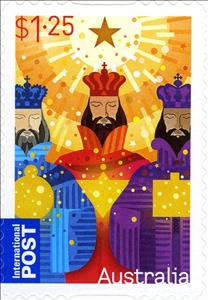Stamp: Three Kings - Christmas (Australia 2009)
Three Kings - Christmas (Australia 2009)
02 November (Australia ) within release Christmas goes into circulation Stamp Three Kings - Christmas face value 1.25 Australian dollar
| Stamp Three Kings - Christmas in catalogues | |
|---|---|
| Michel: | Mi:AU 3322 |
| WADP Numbering System - WNS: | WAD:AU110.09 |
Stamp is vertical format.
SELF-ADHESIVEAlso in the issue Christmas:
- Stamp - Baubles face value 50;
- Stamp - Stocking face value 50;
- Stamp - Mary & Jesus face value 50;
- Souvenir Sheet - Christmas face value 1.75;
- Stamp - Star face value 50;
- Stamp - Tree face value 50;
- Stamp - Presents face value 50;
- Stamp - Three Kings - Christmas face value 1.25;
- Stamp - Star face value 50;
- Stamp - Star face value 50;
- Stamp - Star face value 50;
- Stamp - Tree face value 50;
- Stamp - Tree face value 50;
- Stamp - Tree face value 50;
- Stamp - Presents face value 50;
- Stamp - Presents face value 50;
- Stamp - Presents face value 50;
- Stamp - Baubles face value 50;
- Stamp - Baubles face value 50;
- Stamp - Baubles face value 50;
- Stamp - Stocking face value 50;
- Stamp - Stocking face value 50;
- Stamp - Stocking face value 50;
- Stamp - Mary & Jesus face value 50;
- Stamp - Three Kings - Christmas face value 1.25;
Stamp Three Kings - Christmas it reflects the thematic directions:
Christmas or Christmas Day (Old English: Crīstesmæsse, meaning "Christ's Mass") is an annual festival commemorating the birth of Jesus Christ, observed most commonly on December 25 as a religious and cultural celebration among billions of people around the world. A feast central to the Christian liturgical year, it is prepared for by the season of Advent or the Nativity Fast and initiates the season of Christmastide, which historically in the West lasts twelve days and culminates on Twelfth Night; in some traditions, Christmastide includes an Octave. The traditional Christmas narrative, the Nativity of Jesus, delineated in the New Testament says that Jesus was born in Bethlehem, in accordance with messianic prophecies; when Joseph and Mary arrived in the city, the inn had no room and so they were offered a stable where the Christ Child was soon born, with angels proclaiming this news to shepherds who then disseminated the message furthermore. Christmas Day is a public holiday in many of the world's nations, is celebrated religiously by the vast majority of Christians, as well as culturally by a number of non-Christian people, and is an integral part of the holiday season, while some Christian groups reject the celebration. In several countries, celebrating Christmas Eve on December 24 has the main focus rather than December 25, with gift-giving and sharing a traditional meal with the family.
King is the title given to a male monarch in a variety of contexts. The female equivalent is queen regnant (while the title of queen on its own usually refers to the consort of a king). In the context of prehistory, antiquity and contemporary indigenous peoples, the title may refer to tribal kingship. Germanic kingship is cognate with Indo-European traditions of tribal rulership (c.f. Indic rājan, Gothic reiks, and Old Irish rí, etc.) In the context of classical antiquity, king may translate Latin rex or either Greek archon or basileus. In classical European feudalism, the title of king as the ruler of a kingdom is understood as the highest rank in the feudal order, potentially subject, at least nominally, only to an emperor (harking back to the client kings of the Roman Empire). In a modern context, the title may refer to the ruler of one of a number of modern monarchies (either absolute or constitutional). The title of king is used alongside other titles for monarchs, in the West prince, emperor, archduke, duke or grand duke, in the Middle East sultan or emir; etc. Kings, like other royalty, tend to wear purple because purple was an expensive color to wear in the past.


